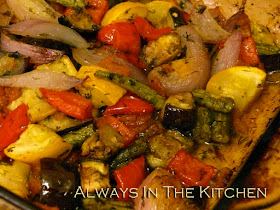Recipe Collections (with photos)
▼
September 09, 2012
Greek Night: Briam and Gigantes
Briam, or Greek-style roasted vegetables, is another entry into the family of mediterranean mixed vegetable dishes, keeping excellent company with French ratatouille and Italian caponata. Each one has its own flavour profile and different texture, born of both seasoning and cooking technique. Each one is highly flexible in terms of which vegetables you choose to include, but is also just a truly excellent way to put that eggplant on your counter to good use. Briam works when served hot, room temperature, or chilled, depending on your needs. It makes a lovely little sandwich/pita filling, and I bet it would make a pretty good omelette filling, too.
The standard cooking method for briam is roasting, and most traditional recipes that I found use a breathtaking amount of olive oil. Now, I'm a big fan of olive oil, both for its culinary and health-related aspects, but recipes that call for a half (or even a whole) cup for a single pan of vegetables do make me shudder a little. Fortunately, you don't actually need that much; you can enjoy your vegetables without drowning in oil.
Some recipes also include potatoes, but I elected not to use them in light of the fact that I was already planning to serve beans on the side. The combination of briam and gigantes turned out even better than I expected, and I will definitely be turning to this combination again. It takes a whole lot of chopping to make this dish, so clear your cutting board and pre-heat the oven.
Briam
Serves 4 - 6
250 grams eggplant
250 grams zucchini (green or yellow)
4 roma tomatoes
1 red onion
6 cloves garlic, whole
100 grams tender green beans
1 red bell pepper (orange or yellow are also good)
1/2 cup minced parsley
1 cup dill weed, minced
3/4 teaspoon kosher salt
1 teaspoon ground black pepper
1/4 cup olive oil
Dice the eggplant into large-ish chunks, and salt heavily. Let stand for 20 minutes, then rinse well (I actually submerge the chunks in cold water), and drain, and squeeze dry with a nice clean towel. Which will then need washing.
Peel and chop the tomatoes; mince the dill and parsley.
Dice the zucchini and all of the other vegetables into similar size pieces to the squeezed-dry eggplant chunks. Leave the garlic cloves whole (add more if you like).
Combine the vegetables in a large roasting pan (I use my 9x13" rectangular pyrex dish). Sprinkle the vegetables with salt and pepper and the fresh herbs, and drizzle with olive oil. Combine well (use your clean hands) until everything is well coated and evenly distributed. Cover the dish lightly with tinfoil, and bake at 400 F for 30 minutes.
Uncover, stir, and bake for another 30 - 40 minutes uncovered, or until liquid is all evaporated and vegetables are nicely roasted and starting to caramelize. Serve hot or cold.
Quick & Easy Gigantes
Serves 4 - 6
This recipe feels a little like a cheat, because you start with canned beans. Want to start with dry beans? Soak 3/4 cup of butter beans overnight, cook (unsalted) very gently for about 30 to 40 minutes, or until tender, drain, and proceed as follows:
4 cups cooked butter beans (or other large white beans)
1/2 medium onion, finely diced
1 tablespoon olive oil
2 tablespoons tomato paste
2 - 3 cloves garlic, minced
2 tablespoons minced dill weed
1/4 teaspoon sugar or honey
1 tablespoon ketchup
1/4 teaspoon kosher salt (omit if using salted canned beans).
Drain and rinse the beans.
Heat the olive oil in a medium skillet. Add the onion and garlic and salt, and saute over medium heat until translucent and tender. Stir in the tomato paste, and cook and stir for about 30 seconds, and then add about a quarter cup of water, and stir until it becomes a nice little sauce. Add the sugar and the ketchup. Stir again and add the beans. Stir until the beans are all nicely coated, and add a little more water.
Bring to a very gentle simmer and let cook on the lowest setting, covered, stirring occasionally, for about 15-20 minutes. Add the dill. Stir through and taste. Adjust for salt if necessary. Continue to cook very gently for another 10 minutes or so.
At any time the dish starts to look dry instead of gently saucy, add a little more water, and stir it through. If the dish looks too wet, increase the heat slightly, and leave uncovered until it has thickened.
These two dishes also bento very well, as I discovered the following day, probably because they are both good hot or cold. I stuffed my leftovers into pita pockets, topped with a little feta (tzatziki would have been good, also), and had a wonderful, filling lunch.


No comments:
Post a Comment